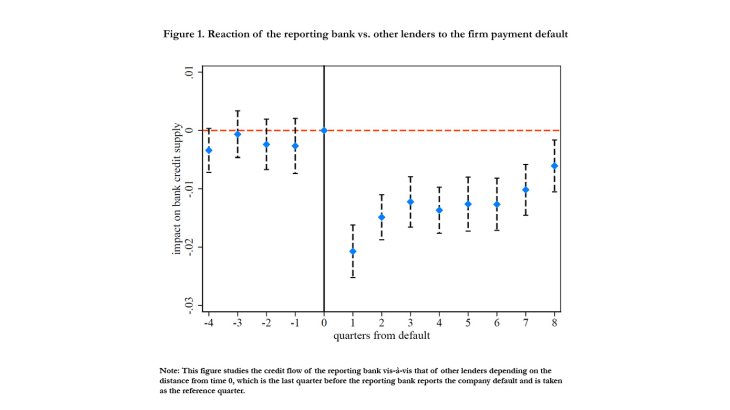How do financial intermediaries process information and use it in credit decisions? Specifically, are banks, which are sophisticated institutions, impacted by the display of information? In this paper, we provide evidence that they are. We show that the salience of information about borrowers affects banks’ lending decisions, with salience being defined as the property to attract the decision maker’s attention automatically and involuntarily.
Our empirical analysis exploits the specificities of the revelation process of trade bill payment default information in France. This offers an ideal setting to study the role of information salience in banks’ lending decisions. The reason is that when a firm fails to pay its supplier on time, the bank operating the payment (henceforth, the reporting bank) observes the default and is obliged, by law, to notify the Banque de France of the default within four working days. The Banque de France then stores this information on its platform, accessible to all lenders. The fact that the information about the default of the borrower is involuntarily received by the reporting bank and the regulatory obligation that requires this bank to notify the default to the central bank increase the prominence—that is, the salience—of the default for the reporting bank. All other lenders, both those with and without a relationship with the defaulting firm, acquire the default information by accessing the Banque de France’s platform, a much less salient way to obtain it.
Existing literature emphasizes that salience amplifies the magnitude of decisions and that risk aversion increases when a negative payoff is made more salient. Hence, under the salience hypothesis, we expect that reporting banks would reduce credit supply to defaulting firms more than other lenders. To test this hypothesis, we consider credit registry data from 2012Q1 to 2019Q4, from which we derive the quarterly credit growth at the firm-bank level. Then, we merge these data with firm-quarter information on payment defaults.
In our baseline analysis, we compare the credit flow offered by the reporting bank vis-à-vis that of other lenders. We focus on firms that borrow from multiple banks at the same time. This permits us to compare the reaction of the reporting bank to that of other lenders for the same borrower, while absorbing the effect of firm-time-specific shocks. We find that all banks decrease their loan supply to defaulting firms. Yet, most importantly, the reaction of the reporting bank is about six times that of other lenders.
Figure 1 visualizes this result by plotting the difference in credit flows between the reporting bank and other lenders around the time the reporting bank reports the payment default. Time 0 denotes the quarter before the default materializes. We see clearly that the reporting bank cuts its lending to the firm relatively more immediately after the default, in line with the salience hypothesis. Importantly, however, reporting and non-reporting banks behave similarly before the firm’s default.
We further test the salience hypothesis by investigating whether the effects amplify when the prominence of the default increases. We find evidence of this. In particular, we document that: i) banks’ reaction is greater when the bank branch lending to the defaulting firm coincides with the bank branch reporting the default; ii) the loan supply reduction is larger the fewer are the defaults reported by the bank branch the day the borrower defaults; and iii) the reaction to a borrower’s default is greater the more time has elapsed since the last payment default reported by the bank branch.
Finally, we consider a battery of tests to dismiss possible alternative hypotheses. First, we provide evidence that our results are not due to firms targeting specific banks at the time of default. Next, we tackle in multiple ways the hypothesis by which information gaps between reporting and non-reporting banks explain our results. In particular, we examine whether differences in the characteristics of the bank-firm relationship and of the lender drive our results by matching bank-firm relationships. Even when we compare reporting banks and other lenders that are similar in terms of length of the relationship with the defaulting firm, market share in the firm’s local market, sector specialization, amount of credit granted to the firm, and size, we still find a more pronounced reaction to the payment default of reporting banks, lending further support to the salience hypothesis.
